Pups have the need to be adored and treasured by their humans. They should never be dumped on the streets and left wondering whether they are worthy of love.
A sweet mama dog and her four puppies who were dumped under a bridge needed love, too.
Sadly, they were let down by their owners and left to fend for themselves when they most needed the warmth and comfort of a home.
The mother dog felt frightened and worried whether she would be able to find any scraps of food in order to keep her babies alive.
Enduring hunger and cold, the brave mama dog and her puppies hoped that someone would notice them and bring them to safety.
Receiving Help
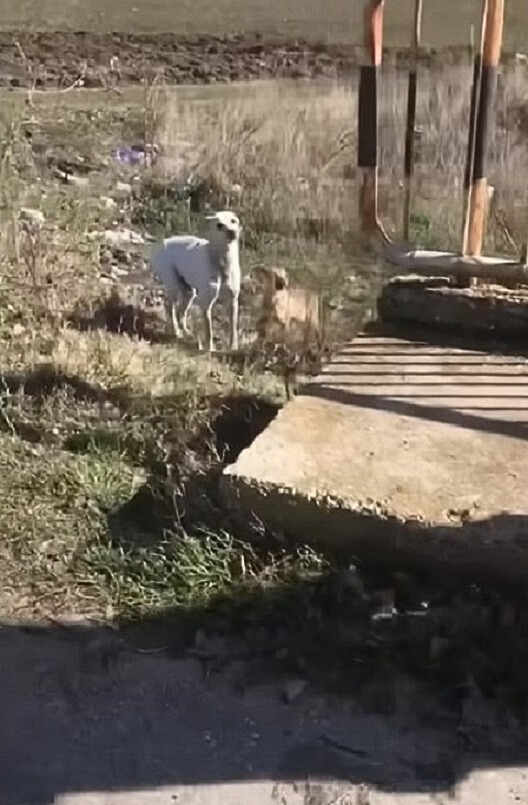
As soon as a rescuer got a call from his friend and learned that there was a canine family living under a bridge, he rushed to help them.
When he arrived at the location and saw how weak and frightened they were, the rescuer felt sad.
He tried to approach the mama dog and her puppies, but they were timid, and they kept their distance.
The kind human gave them food, and the hungry mama dog and her pups started eating. They were happy to finally have a proper meal.
Later that day, the rescuer brought water and more food for the sweet family.

The mother dog wagged her tail as soon as she saw that he had returned, but she didn’t let the rescuer get close to her.
He hoped to gain their trust and bring them to safety as soon as possible.
The next day, two rescuers arrived at the bridge with the hope of rescuing the canine family. Soon, they realized that it wouldn’t be so easy to capture the puppies. They were running around, full of energy.
The mama dog’s heart melted when she saw that the kind rescuers kept leaving food and water for her and her pups. She realized that they were good humans, and she approached them without fear.
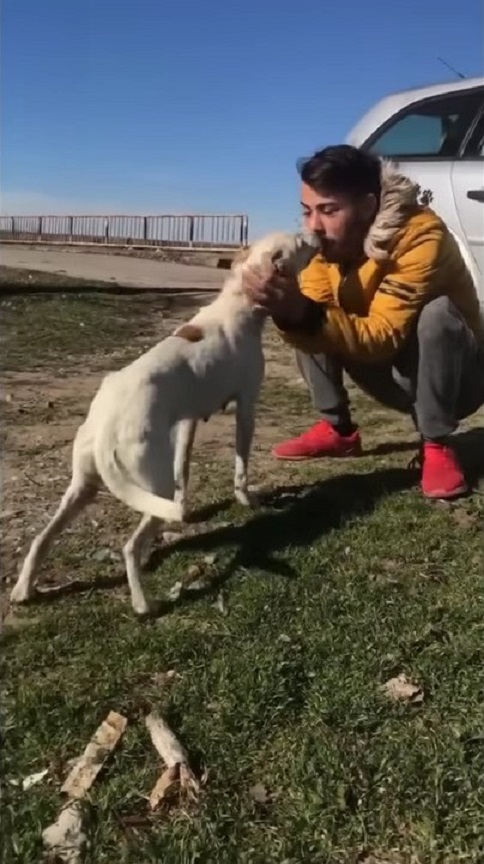
The rescuers cuddled the sweet doggo, and felt very happy because they gained her trust. The mother dog soaked up the love they gave her, and her beautiful eyes became hopeful.
The giant-hearted people kept visiting and feeding the adorable dogs twice a day.
Bringing Them To Safety
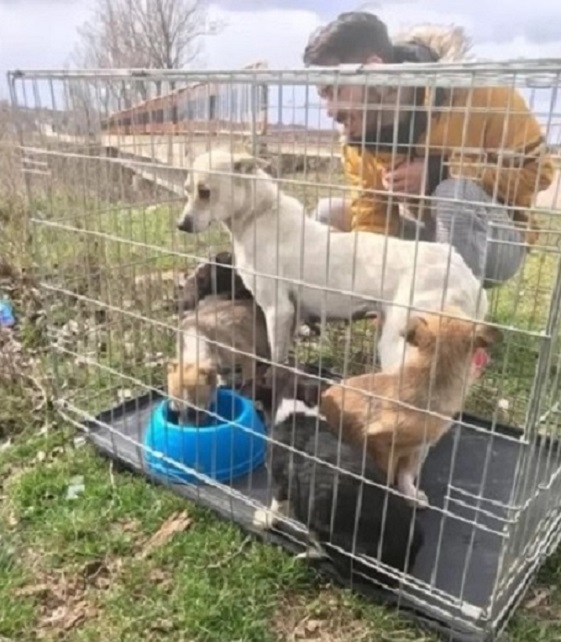
On day four, the rescuers succeeded in luring the mother dog and her babies into a crate with food.
They felt overjoyed because they rescued the abandoned canines.
The doggo and her puppies were taken to a rescue. Their rescuers showered them with a lot of love and provided them with care.
The canine family felt safe and cherished.
The mama dog, later named Lucy, was extremely grateful to the rescuers. Whenever Lucy saw her heroes, she jumped to greet them. With a smile on her face, she asked for cuddles.
Finding The Happiness They Dreamed Of
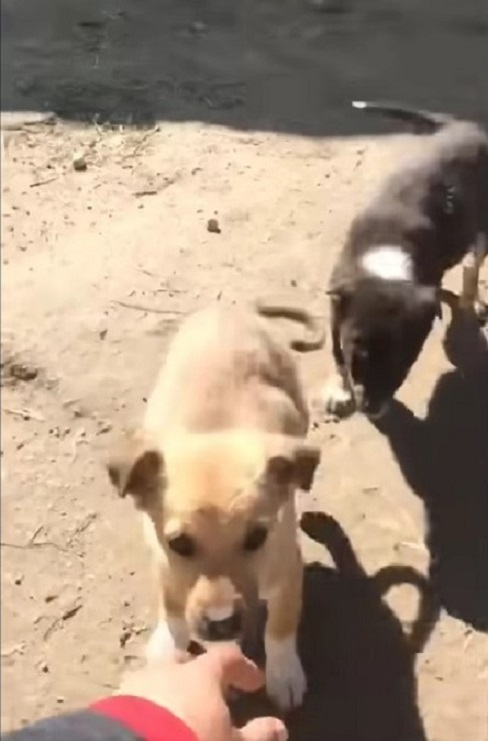
Lucy and her pups started searching for a loving home.
It didn’t take long for the puppies to find great forever families who welcomed them with outstretched arms.
For some time, Lucy didn’t get any adoption applications.
Her rescuers continued doting on her and giving her love, believing that she would find her happiness.
Six months later, the beautiful pooch stole the heart of a wonderful family, who gave her a loving home that she deserved.
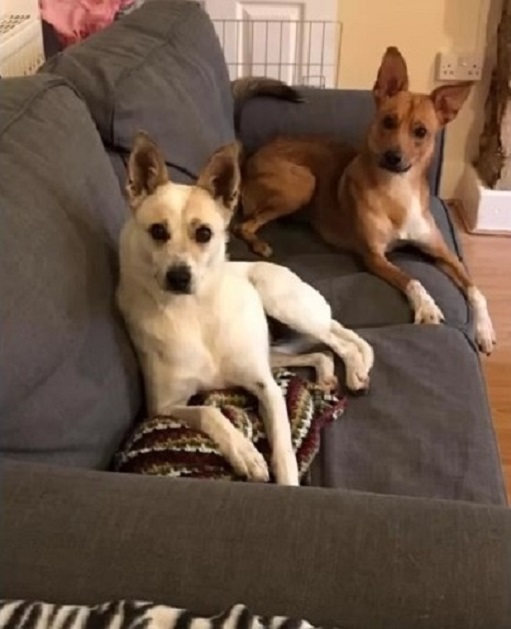
It was the same family who adopted Dustin, one of Lucy’s puppies. The mother and her pup were overjoyed to be reunited.
We’re happy that they found the families who treasure them and make them feel loved.
If you’ve ever noticed your furry friend’s belly suddenly expanding like a balloon, you might be witnessing a serious condition known as bloat. Picture this: you’re playing fetch in the park, and out of nowhere, your dog’s abdomen seems to swell up. It’s not just a big meal causing this. Bloat, also called gastric dilatation-volvulus (GDV), is a frightening and potentially life-threatening issue that can strike unexpectedly.
Imagine your loyal companion experiencing discomfort and distress as their stomach fills with gas or fluid, putting pressure on their organs and cutting off blood flow. Recognizing the signs of bloat and understanding how to prevent it could be crucial in safeguarding your pup’s well-being. Stay tuned to learn more about this alarming condition and how you can keep your canine companion safe and healthy.
Understanding Canine Bloat
When it comes to understanding canine bloat, it’s crucial to recognize that this condition, also known as gastric dilatation-volvulus (GDV), is a serious and potentially life-threatening issue for dogs. Bloat occurs when a dog’s stomach fills with gas, fluid, or food, causing the abdomen to swell rapidly.
Signs of Canine Bloat:
- If your dog is restless and pacing, trying to vomit but unable to, and has a swollen abdomen, these could be signs of bloat.
- Other symptoms may include excessive drooling, pale gums, and a rapid heartbeat. It’s essential to act quickly if you notice these signs.
Risk Factors:
- Large breed dogs with deep chests, like Great Danes and Weimaraners, are more prone to bloat.
- Eating too quickly or exercising right after meals can also increase the risk of bloat in dogs.
Preventing Canine Bloat:
- To help prevent bloat, consider feeding your dog smaller, more frequent meals throughout the day rather than one large meal.
- Limit strenuous exercise before and after meals, and ensure your dog eats at a slower pace.
Seeking Veterinary Care:
- If you suspect your dog has bloat, don’t delay seeking veterinary assistance. Time is of the essence in treating this condition.
In Conclusion:
Understanding canine bloat is crucial for every dog owner. Knowing the signs, risk factors, and preventive measures can help safeguard your furry friend’s well-being. Stay vigilant, act promptly, and remember that your quick action could save your dog’s life.
Causes of Bloat in Dogs
When it comes to bloat in dogs, understanding the causes is crucial for prevention and timely intervention. Here are the key factors that contribute to this serious condition:
- Eating Habits: Dogs who eat their meals rapidly or consume large amounts of food in a short period are at a higher risk of bloat. Encouraging your dog to eat slowly can help reduce the likelihood of this condition.
- Physical Activity: Engaging in strenuous exercise, particularly right after eating, can increase the chances of bloat occurring. It’s essential to give your dog some time to digest before vigorous activities.
- Breed Predisposition: Certain dog breeds, such as Great Danes, Standard Poodles, and Weimaraners, are more prone to developing bloat. Being aware of your dog’s breed characteristics can help you take preventive measures.
- Anatomy: The anatomy of some dogs, like those with a deep chest, may make them more susceptible to bloat. Understanding your dog’s unique physiology can aid in proactive management.
- Stress and Anxiety: Environmental stressors or changes can also contribute to the onset of bloat in dogs. Creating a calm and comforting environment for your furry friend is beneficial in reducing this risk factor.
By being mindful of these causes and taking proactive steps in your dog’s care routine, you can significantly lower the chances of bloat occurrence. Remember, a little awareness and preventive measures can go a long way in safeguarding your canine companion’s health.
Recognizing Symptoms of Bloat
When it comes to identifying bloat in dogs, paying attention to certain signs can help you act promptly and potentially save your furry friend’s life. Here are the key symptoms to watch out for:
- Restlessness: If your dog seems unusually restless or anxious, it could be a sign of bloat. Keep an eye on any changes in their behavior, especially after eating or exercising.
- Unsuccessful Attempts to Vomit: Dogs with bloat may try to vomit but have no success in bringing anything up. This unproductive retching is a red flag that shouldn’t be ignored.
- Distended Abdomen: One of the most noticeable signs of bloat is a visibly swollen or bloated abdomen. If your dog’s belly looks unusually expanded and feels tight to the touch, it could indicate a serious issue.
- Excessive Drooling: Dogs experiencing bloat may drool excessively due to discomfort and nausea. Pay attention to any sudden increase in drooling that seems out of the ordinary.
- Difficulty Breathing: Rapid, shallow breathing or panting heavily, especially if accompanied by other symptoms, can indicate bloat and the need for immediate veterinary care.
Recognizing these symptoms early on can make a significant difference in getting timely medical attention for your pet. Keep a close eye on your dog’s behavior and physical condition, and consult a vet if you notice any of these warning signs of bloat.
Treatment and Management of Bloat
When it comes to the treatment and management of bloat in dogs, every second is crucial. If you suspect your dog has bloat, rush them to a veterinary clinic immediately – this is a life-threatening emergency.
- Emergency Medical Intervention: The vet will first stabilize your dog by providing oxygen therapy, intravenous fluids, and alleviating shock if present. X-rays may be taken to confirm the diagnosis.
- Decompression: To relieve the pressure in the stomach, the vet may pass a tube through the esophagus or perform needle decompression by inserting a large-bore needle directly into the stomach.
- Surgery: In severe cases or if the stomach has rotated (volvulus), emergency surgery is necessary. During surgery, the vet will detwist the stomach and assess any damage to surrounding organs.
- Postoperative Care: After surgery, your dog may require intensive care and monitoring. This involves pain management, antibiotics to prevent infection, and support for compromised organs.
- Preventive Gastropexy: If your dog has experienced bloat, the vet may recommend a preventive procedure called gastropexy. This surgery involves attaching the stomach to the body wall to prevent future twisting.
Remember, the key to saving your dog’s life in a bloat emergency is acting fast. Knowing the signs, seeking immediate veterinary attention, and following the treatment plan are crucial steps in ensuring the best outcome for your beloved pet.
Long-Term Implications of Bloat
After surviving an episode of bloat, your dog may face potential long-term effects that could impact their health and well-being. It’s essential to remain vigilant and aware of these consequences to provide the necessary care for your furry companion. Here’s what you should keep in mind:
Digestive Issues:
Following bloat, some dogs may experience ongoing digestive problems such as reduced appetite, vomiting, or diarrhea. Monitoring their eating habits and bowel movements can help you identify and address any concerning issues promptly.
Gastric Sensitivity:
Dogs that have had bloat are often more prone to gastric sensitivity. This means that certain foods or dietary changes could trigger discomfort or digestive disturbances. Consult with your veterinarian to determine the most suitable diet for your dog’s condition.
Increased Risk of Recurrence:
Once a dog has had bloat, there is a heightened risk of recurrence. It’s crucial to take preventive measures, adhere to dietary recommendations, and avoid factors known to contribute to bloat development.
Behavioral Changes:
Some dogs may exhibit behavioral changes after experiencing bloat, such as anxiety or fearfulness. Providing a supportive and comforting environment can help ease any emotional distress your dog may be experiencing.
Long-Term Veterinary Monitoring:
Regular check-ups with your veterinarian are vital to monitor your dog’s overall health post-bloat. These visits can help detect any potential issues early and ensure that your dog receives timely interventions as needed.
Understanding and addressing the long-term implications of bloat are crucial steps in safeguarding your dog’s health and happiness post-recovery. By staying informed and proactive, you can help your beloved pet lead a fulfilling life despite their previous bloat experience.
Conclusion
So, there you have it – bloat in dogs is no joke. Remember, spotting the signs early and getting your furry friend to the vet ASAP is key. The aftermath of bloat can bring about some lasting issues like tummy troubles, sensitivity, and even behavioral changes. It’s essential to keep a close eye on your pup and have regular check-ups post-recovery. Stay informed, stay vigilant, and keep your pup’s well-being a top priority.
Frequently Asked Questions
What is bloat in dogs?
Bloat, or gastric dilatation-volvulus (GDV), is a serious condition where a dog’s stomach fills with gas and twists, leading to potentially life-threatening consequences if left untreated.
What are the symptoms of bloat in dogs?
Symptoms of bloat in dogs can include a distended abdomen, unproductive retching, restlessness, excessive drooling, and rapid breathing.
What are the risk factors associated with bloat in dogs?
Risk factors for bloat in dogs include eating too quickly, exercising vigorously after eating, breed predisposition (deep-chested breeds), and having a close relative with a history of bloat.
How can bloat in dogs be prevented?
Prevention strategies for bloat in dogs include feeding multiple small meals a day, using slow-feed bowls, avoiding exercise immediately after eating, and raising food bowls to shoulder height for large breeds.
How is bloat in dogs treated?
Treatment for bloat in dogs typically involves stabilizing the dog, decompressing the stomach, and surgical correction if necessary to prevent recurrence.
What are the long-term implications of bloat in dogs?
Long-term implications of bloat in dogs include digestive issues, gastric sensitivity, increased risk of recurrence, behavioral changes, and the need for ongoing veterinary monitoring post-recovery.
[no_toc]

Hey there, I’m Janet Brooks, a dog-loving student from California. I’m all about helping pups in need, especially those without homes. Me and my awesome friends work together to give shelter and love to stray dogs. Oh, and I also write blogs about dogs to share helpful info.